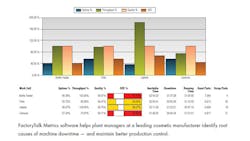Ancient Greeks lined their eyes with kohl, and Romans dabbed their faces with rosewater. But never have we seen such demand for beauty products as today.
The global cosmetics industry is a multibillion-dollar business — and growing. A few multinational corporations produce nearly half of the world’s cosmetics, and for the thousands of other manufacturers, competition is keen. Production quality and efficiency are imperative to business survival.
One leading global cosmetics manufacturer recently added a new line to its Dallas plant to increase production quantities of mascaras and lip glosses, bringing the plant’s total number of production lines to 29. Plant management expected the new line to produce 100 to 120 containers per minute. However, once production went online, output was disappointing, and frequent line stoppages occurred.
To improve its measurement of overall equipment efficiency (OEE) and gain greater control over the efficiency and quality of the new line, management enlisted the help of Lewisville, Texas-based Prime Controls, an information and control construction firm and Solution Partner in the Rockwell Automation PartnerNetwork™.
“The new line was logging an incredible amount of downtime,” says Bill Bivens, vice president of business development for Prime Controls. “The customer recorded in excess of 2,500 stops/starts per 12-hour shift, and they couldn’t detect the source of the problem.” The plant lacked the manufacturing intelligence it needed for root-cause analysis.
Using Data Efficiently
Prime Controls implemented a manufacturing intelligence solution using FactoryTalk® Metrics software from Rockwell Automation to monitor, collect and analyze data efficiently. The application can collect and provide reports on any machine events that can be detected in the control system. Prime Controls evaluated existing operations on the new line, designed as a chain of multiple transfer conveyors with five work-cell stations.
An Allen-Bradley® ControlLogix® programmable automation controller (PAC) and Allen-Bradley CompactLogix™ PAC automate the production machinery, including bottle feeders, fillers, labelers, cartoners and packers. All controllers are tightly synchronized via the plant’s EtherNet/IP™ network. However, integration between machine controls and the plant’s existing manufacturing software was less effective and limited to barcode readers that required operators to leave their workstation to select a fault manually for any downtime. Many shorter periods of downtime were never tied to any fault.
Prime Controls engineers designed logic and configured the new software to assign downtime automatically to a specific root fault or other events, effectively determining the source of line stoppages. The Prime Controls team installed FactoryTalk Metrics software on a local server and connected the program directly to the plant’s network.
After migrating the existing application to the FactoryTalk database, engineers analyzed the line in running mode. They determined the machine with the highest OEE rating was running at maximum level, while other machines were either starved or blocked — something that wasn’t visible to the human eye. The first machine on the line —the bottle feeder — was in starved status 60 minutes per shift. This was an easy fix, because it only requires proper stocking.
They also realized the labeler was switching states too rapidly. After attributing all downtime to specific faults, engineers began editing existing programming codes. They decreased the labeler’s buffer alarm to prevent the machine from switching into starved mode too frequently. Engineers then configured the FactoryTalk software to calculate and visualize OEE for the monitored equipment. Now, when operators are notified of an alarm, they easily can understand the cause of stoppage or inefficiency, and access the data they need to identify actionable areas for improvement.
Measurable Results
With FactoryTalk Metrics software, key performance indicators (KPIs) and other vital data are easily accessible via Web browser. Using contextual, real-time machine and line data, plant management now can establish meaningful production metrics beyond an improved OEE score to achieve significant cost reductions.
Since implementing FactoryTalk Metrics software, plant management has the granular answers they need to understand the “why” of machine performance, pinpointing the causes of downtime and loss. The result is measurable improvements in production quality and efficiency. The plant has reduced per-shift machine starts/stops by 90% — from 2,500 to 250. It also recorded a 15 to 20% increase in uptime and is saving $100,000 annually i service-contract costs and productivity improvements.
“The customer now has the transparent machine status they needed all long,” Bivens says. “Plant management can evaluate product-loss calculations and true machine efficiency, and maintenance managers can see a list of downtime events relative to actual machine alarm codes.” With new, granular manufacturing intelligence, the cosmetics manufacturer can evaluate line deficiencies easily and identify needed improvements, giving management the knowledge and confidence they need to keep pace with their demanding industry.
Prime Controls, based in Lewisville, Texas, is a Rockwell Automation Solution Partner. The company is a system integration and information and control construction firm serving automation and control needs for companies in the oil and gas
